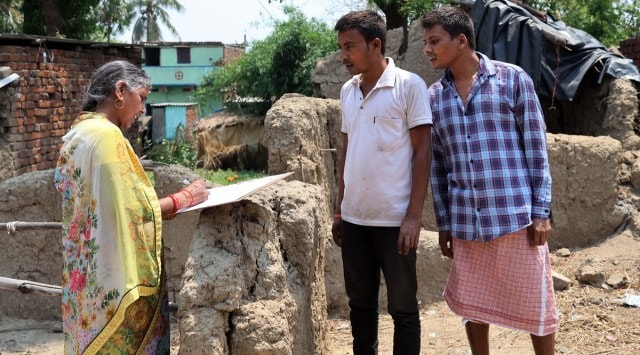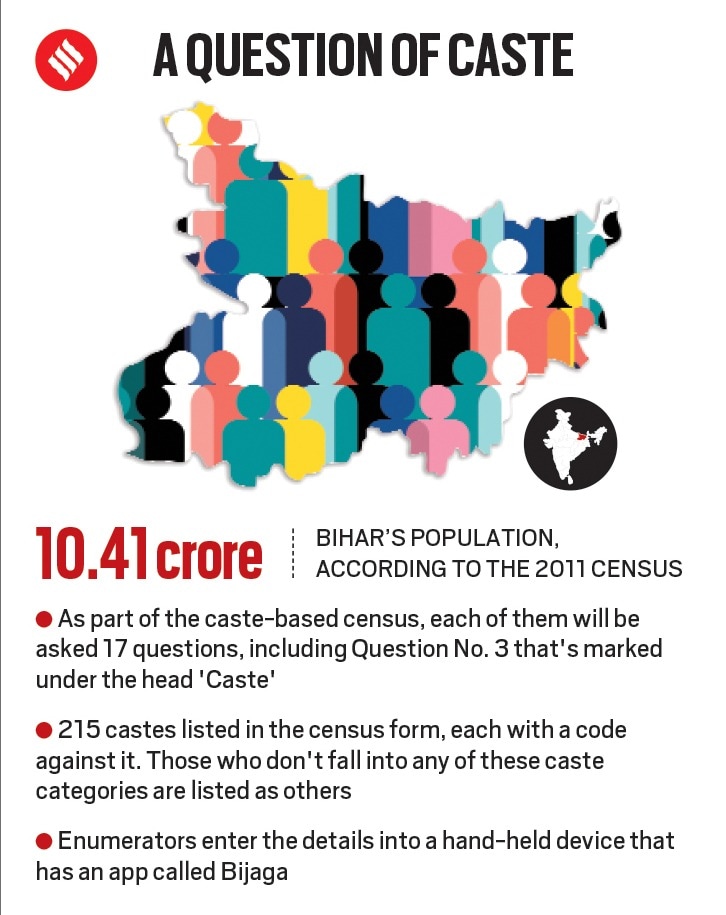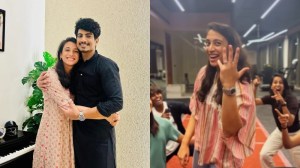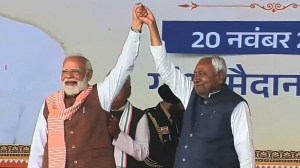It’s 10.30 on a Monday morning and enumerator Kavita Kumari, 30, has just popped the question.
While the Centre has said no to a nation-wide caste census, in Bihar, with all political parties, including the BJP, joining hands to back Nitish’s call for a caste census, the state, with a nod from the Supreme Court, became the first state to launch the two-phased caste-based headcount on January 7 this year.
As with the Census conducted by the Registrar General of India (RGI), the first phase of Bihar’s ‘Jaati Aadharit Ganana’ or Bihar Caste-Based Survey, which lasted until January 21, involved a houselisting exercise as part of which enumerators counted houses and families.
 Kalyanbigha, which is part of Barah panchayat in Gharnaut Assembly segment in Nalanda, is the ancestral home of JD(U) supremo and Bihar Chief Minister Nitish Kumar. Picture by Ranjan Rahi
Kalyanbigha, which is part of Barah panchayat in Gharnaut Assembly segment in Nalanda, is the ancestral home of JD(U) supremo and Bihar Chief Minister Nitish Kumar. Picture by Ranjan Rahi
The ongoing second phase, which kicked off on April 15, involves an army of enumerators, mostly school teachers, fanning out across the state, armed with a set of 17 questions – name, gender, marital status, religion, educational qualification, and, among others, that most contested of them all, in Column No. 3 that’s marked ‘Caste’.
 Bihar’s population according to the 2011 census. (Express Photo)
Bihar’s population according to the 2011 census. (Express Photo)
Kalyanbigha, part of Barah panchayat in Gharnaut Assembly segment in Nalanda, is the ancestral home of JD(U) supremo and Chief Minister Nitish Kumar. The village of over 500 families has a dominant population of Kurmis, part of the Other Backward Classes (OBCs), followed by Scheduled Caste Manjhis. The village also has the Extremely Backward Classes (EBCs) of Kahaars and Nais, besides OBC Yadavs, upper-caste Brahmins, and a lone family of the Scheduled Caste Doms.
Story continues below this ad
In Kalyanbigha, several houses are under lock, including that of its most famous non-resident: Chief Minister Nitish Kumar. The two-storey pucca house, which stood as a brick-and-mud structure with a thatched roof until a few years ago, will be counted as a ‘non-residential house’ by the Census team today.
As Kavita Kumari’s pencil hovers over Column No. 3, Dilip Kumar, 64, responds: “Kurmi”. It’s one of the 216 castes listed in Kavita’s form. An OBC and agrarian caste to which Nitish himself belongs, Kurmis make up one half of the famed Kurmi-Kushwaha combination that is courted by almost all parties.
 Dilip Kumar hoped the Bihar government does something for the poor based on the results of the caste-based survey. Dilip and his wife Minshu Kumari (left) answer questions in Nalanda’s Kalyanbigha. Picture by Ranjan Rahi
Dilip Kumar hoped the Bihar government does something for the poor based on the results of the caste-based survey. Dilip and his wife Minshu Kumari (left) answer questions in Nalanda’s Kalyanbigha. Picture by Ranjan Rahi
Dilip Kumar breezes through the 17 questions that are put to him: names of his family members, marital status, religion, educational qualification, work status, monthly income, and so on. Dilip declares he is a farmer with six bighas of agricultural land, earns a monthly income of Rs 5,000, has studied up to Class 10 and that his son, Suryakant Kumar, works in a private company.
“Achchha hai sab jati ki ginti ho jayegi…Kuchh na kuchh sarkar karegi hi garibon ke liye (It is good that all castes will be counted. The government will do something for the poor),” says Dilip.
Story continues below this ad
His neighbour Brajesh Kumar, 51, who lives in a brick-and-tile house and who owns six bighas, tells the enumerator that he earns an average monthly income of “Rs 6,000” and declares himself a Kurmi.
 Brajesh Kumar, who refused to show the enumerator his Aadhaar card citing a rise in frauds, said only politicians stood to gain from exercises like caste-based surveys. Seen here, Brajesh with the enumerator in Nalanda’s Kalyanbigha. Picture by Ranjan Rahi
Brajesh Kumar, who refused to show the enumerator his Aadhaar card citing a rise in frauds, said only politicians stood to gain from exercises like caste-based surveys. Seen here, Brajesh with the enumerator in Nalanda’s Kalyanbigha. Picture by Ranjan Rahi
As Kavita asks for his identity card, Brajesh Kumar says, “I can’t give you my Aadhaar card as it is linked to my bank account. There is a lot of fraud happening these days.” He finally settles on his ration card that lists his wife Pinky Kumari, 18-year-old daughter Priya and 16-year-old son Ayush.
Brajesh is not convinced about the survey. “It is only politicians who stand to gain from such an exercise, not common people like us.”
Metres away, in Ward No 13 of the village, enumerator Rajani Kumari has already been to around five homes and hopes to complete the survey at three more homes by evening.
Story continues below this ad
 A brief history of caste and census in Bihar. (Express Photo)
A brief history of caste and census in Bihar. (Express Photo)
Rajani Kumari, 33, a high school teacher who heads a unit of six enumerators, including the team in Kalyanbigha, says, “People may have their opinion but almost everyone is willing to be counted. But we know that most people play down their income or provide incomplete information because they think they’ll stand to gain that way… they think maybe the government will extend them some benefits.”
It’s a scene that plays out as Rajani Kumar visits the house of Ramiqbal Yadav, 55.
Ramiqbal’s wife Ramkumari Yadav, who answers the enumerator’s questions, says theirs is a family of 10 and that her husband Ramiqbal sells vegetables in Surat. She declares his income as Rs 5,000 a month. As Rajani sounds sceptical – “why would he leave the state to work for such meagre earnings?”, Ramkumari protests loudly, “I am not lying. That’s how much he earns. I do not know why he did not want to work in Bihar. Anyway, what is the point of this exercise? Why is the government counting castes? Will anything good come of this?”
 While her husband is in Gujarat to provide for their family of 10, Ramkumari Yadav (right) stays in Bihar. Though she wondered about the point of conducting a caste-based survey, Ramkumari answered the enumerator’s questions in Nalanda’s Kalyanbigha. Picture by Ranjan Rahi
While her husband is in Gujarat to provide for their family of 10, Ramkumari Yadav (right) stays in Bihar. Though she wondered about the point of conducting a caste-based survey, Ramkumari answered the enumerator’s questions in Nalanda’s Kalyanbigha. Picture by Ranjan Rahi
It’s a cue for enumerator Rajani Kumari to rush through the remaining questions and move to the next house. “After we are done with the survey, we have to feed all the information into the app. It takes close to two hours to upload all the details,” she says.
Story continues below this ad
Sangeeta Kumari, 50, the third enumerator in Kalyanbigha today, has been assigned 245 houses, most of these on the outskirts of the village, in Ward No. 14, where the Scheduled Castes live.
As Sangeeta heads towards one of the SC Manjhi families, Raja Malik, 25, calls out to her: “Madam, ek hi ghar hain hum logon ka, pahle hamara ghar dekh liya jaaye (We are just one family… please survey us before you move on).”
 Raja Malik is a science graduate who is unemployed. He told the enumerator in Kalyanbigha, Nalanda, that he belongs to the only Dom family in the village. Doms, one of the 21 Scheduled Castes in the state, make up less than 1 per cent of the state’s population. Picture by Ranjan Rahi
Raja Malik is a science graduate who is unemployed. He told the enumerator in Kalyanbigha, Nalanda, that he belongs to the only Dom family in the village. Doms, one of the 21 Scheduled Castes in the state, make up less than 1 per cent of the state’s population. Picture by Ranjan Rahi
Brothers Raj Malik and Raja Malik belong to the only Dom family in the village. Doms, one of the 21 Scheduled Castes in the state and socially one of the most vulnerable, make up less than one per cent of the state’s population.
Standing out their mud house, Raj Malik says, “I am a science graduate but unemployed. My father owns this house. I don’t have a house to my name.”
Story continues below this ad
His brother Raja Malik adds, “I hope that after the caste survey, the government gives priority to those who do not have a house.”
 The Bihar survey. (Express Photo)
The Bihar survey. (Express Photo)
The survey will be completed on May 15 and the final report is likely to be tabled in the monsoon session of the Bihar legislature in July.
Some 28 kilometers from Kalyanbigha, a town adjoining Biharsharif, the district headquarters of Nalanda that’s still scarred from the recent communal violence during the Ramnavami procession, Akhilesh Kumar, 55, who runs a sweet shop in the town and belongs to the OBC community, is unhappy about the survey. “The census only counts castes, not sub-castes. There are so many sub-castes among us Banias (an OBC group) and we have all been put under different heads in the survey. Hinduon ko baantne ki koshish ho rahi hai (This is just an attempt to divide Hindus).”



 Kalyanbigha, which is part of Barah panchayat in Gharnaut Assembly segment in Nalanda, is the ancestral home of JD(U) supremo and Bihar Chief Minister Nitish Kumar. Picture by Ranjan Rahi
Kalyanbigha, which is part of Barah panchayat in Gharnaut Assembly segment in Nalanda, is the ancestral home of JD(U) supremo and Bihar Chief Minister Nitish Kumar. Picture by Ranjan Rahi Bihar’s population according to the 2011 census. (Express Photo)
Bihar’s population according to the 2011 census. (Express Photo) Dilip Kumar hoped the Bihar government does something for the poor based on the results of the caste-based survey. Dilip and his wife Minshu Kumari (left) answer questions in Nalanda’s Kalyanbigha. Picture by Ranjan Rahi
Dilip Kumar hoped the Bihar government does something for the poor based on the results of the caste-based survey. Dilip and his wife Minshu Kumari (left) answer questions in Nalanda’s Kalyanbigha. Picture by Ranjan Rahi Brajesh Kumar, who refused to show the enumerator his
Brajesh Kumar, who refused to show the enumerator his  A brief history of caste and census in Bihar. (Express Photo)
A brief history of caste and census in Bihar. (Express Photo) While her husband is in Gujarat to provide for their family of 10, Ramkumari Yadav (right) stays in Bihar. Though she wondered about the point of conducting a caste-based survey, Ramkumari answered the enumerator’s questions in Nalanda’s Kalyanbigha. Picture by Ranjan Rahi
While her husband is in Gujarat to provide for their family of 10, Ramkumari Yadav (right) stays in Bihar. Though she wondered about the point of conducting a caste-based survey, Ramkumari answered the enumerator’s questions in Nalanda’s Kalyanbigha. Picture by Ranjan Rahi Raja Malik is a science graduate who is unemployed. He told the enumerator in Kalyanbigha, Nalanda, that he belongs to the only Dom family in the village. Doms, one of the 21 Scheduled Castes in the state, make up less than 1 per cent of the state’s population. Picture by Ranjan Rahi
Raja Malik is a science graduate who is unemployed. He told the enumerator in Kalyanbigha, Nalanda, that he belongs to the only Dom family in the village. Doms, one of the 21 Scheduled Castes in the state, make up less than 1 per cent of the state’s population. Picture by Ranjan Rahi The Bihar survey. (Express Photo)
The Bihar survey. (Express Photo)





